This WordPress blog is not public.
The air is full of pollinators as I’ve got myself a nectar bar in the garden full of rich nectar flowers. In fact sometimes it’s very hard not to become distracted from the weeding. If you’re like me and you like to photograph them then you’ll realise that
sometimes not a lot of weeding gets done in the garden. We’ve even had a rare glimpse of a
Pearl Border Fritillary butterfly in the garden this month. It’s in the decline across the UK. As a result it’s a priority species for conservation in the UK.
Many of the plants I have flowering in August are great sources of nectar and pollen. There’s a ‘special menu’ in the garden for butterflies as they can reach the down into the flowers with deep nectaries. While there are also plenty of sweeter nectar flowers for the bees. So come and join me as we see who’s been drinking recently at our Nectar Bar…
Rich Nectar Flowers
Geranium
 |
| The rich nectar flowers of Geranium Rozanne (‘Gerwat’) |
Geranium ‘Rozanne’ is a fantastic plant to have in the garden. Indeed it’s the longest flowering geranium that I grow. One plant can cover a metre square of soil. As a result it looks terrific with mauve blue flowers all summer and early autumn. The bees love it just as much as I do. The RHS love it just as much too. It was awarded the title
‘Plant of the Centenary’ as it’s the best plant launched commercially between 1993 and 2002.
Hedge Germander
Around one corner of the pond is a large swathe of Hedge Germander | Teucrium x lucidrys.
 |
| Hedge Germander | Teucrium x lucidrys – rich nectar flowers |
It flowers in late summer and has pink upright spires of tiny pink flowers. The bees love these flowers.
Oregano ‘Country Cream’
There’s also another favourite and it’s the herb Oregano ‘Country Cream’. I’m growing more herbs this year in the garden but this one certainly gets the most attention.
 |
| Oregano ‘Country Cream’ and bee aerobics – rich nectar flowers |
Posturing Maybe?
Usually when bees lift their middle leg it means that your camera lens is getting too close to them. They feel threatened and posture at you. If you back away they’ll usually move their leg back down again. Furthermore if you don’t they’ll probably turn around and show you their little sting. Moreover if that still doesn’t deter you they might fly at you to get you to move away … but very rarely will they sting you. I have to thank
Bee Strawbridge who through her very informative bee blog enlightened me about this
‘bee-haviour’. I don’t think this bee was posturing at me but was just moving from one oregano flower to another as I pressed the shutter.
Astrantia
Then there’s the Astrantia which is also a favourite with some of the flies too… never mind a few wasps.
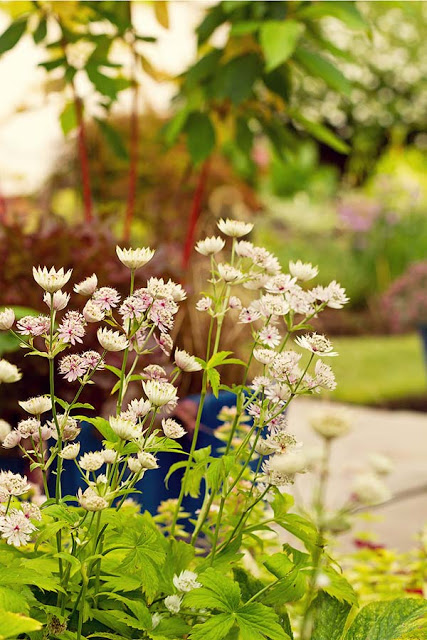 |
| Astrantia – rich nectar flowers |
 |
| clinging on |
When I grew this Astrantia in the shade the flowers were a more whiter shade. I need to remind myself again to split the plant and move some back into the shade as it develops more of a pinkish hue when planted in full sun. I like it best when the white is more defined in the blooms.
Linaria
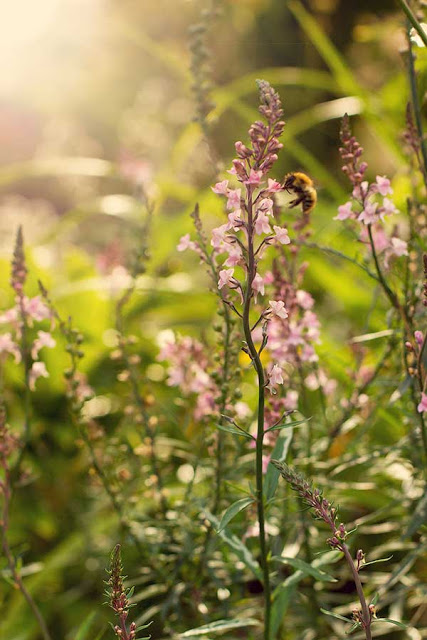 |
| Linaria purpurea ‘Canons Went’ – rich nectar flowers |
I’ve got lots of Linaria purpurea that appears all over the front garden in the oddest of places. I never bought the plant and it just appeared one year. It has tiny snapdragon shaped flowers in shades of purple and pink. Many a time it gets pulled up like a weed! Unlike this Linaria which was purchased as Linaria purpurea ‘Canons Went’. The bees love this plant and it grows next to the Astrantia (previous image).
Eryngium
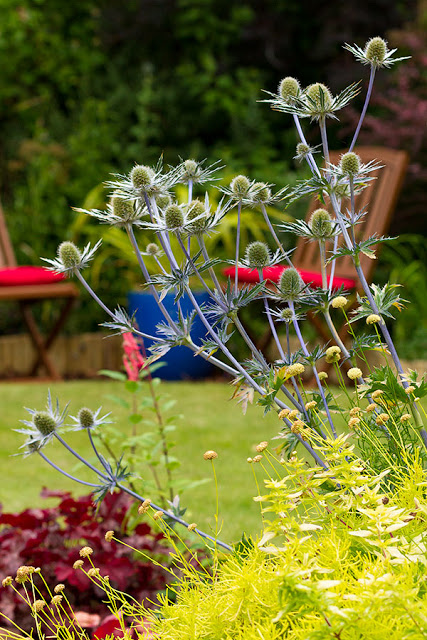 |
| Eryngium bourgatii ‘Picos Blue’ |
The bees love this sea holly Eryngium bourgatii ‘Picos Blue’ too and its spiky bracts contrast so well with the tiny yellow leaves from Santonlina ‘Lemon Fizz’.
 |
| Eryngium bourgatii ‘Picos Blue’ – rich nectar flowers |
It’s very popular with the bees in July and early August.
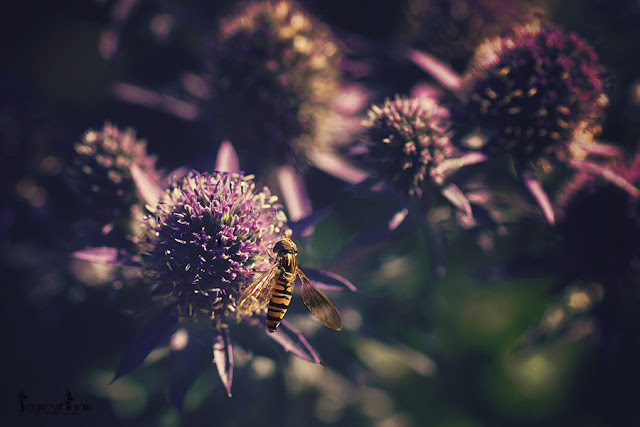 |
| Hoverfly on Eryngium ‘Blue Hobbit’ – rich nectar flowers |
While Eryngium ‘Blue Hobbit’ is still attracting bees and hoverflies.
Low in Sugar Choices
In previous years I’ve had to buy new Verbena bonariensis plants as it’s just too cold here to get them through the winter. This year I only bought a couple of new plants as I’ve been growing more and more Verbena hastata. This plant grow in shades of pink, blue and white and is hardy enough to cope with our cold winters.
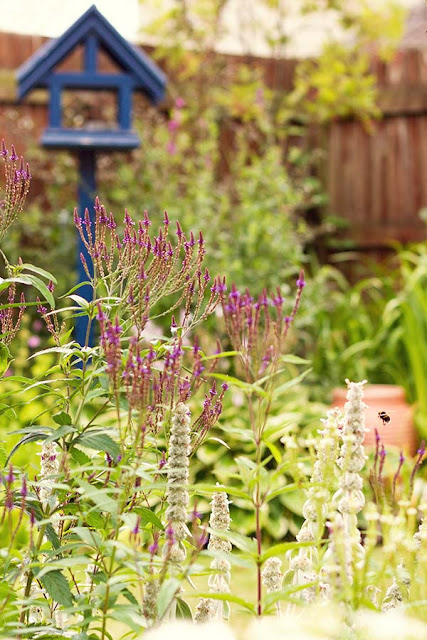 |
| Verbena hastata ‘Blue Spires’ and Stachys lanata – rich nectar flowers |
I grow the Verbena hastata ‘Blue Spires’ in amongst the bees favourite plant the woolly and silver leafed Stachys lanata. This verbena seems to be the stronger and more vigorous of all the 3 colours and readily seeds in the garden.
Bees Have A Sweet Tooth
The bees don’t favour the Verbena nectar at all as their shorter tongues can’t dip into it unlike the butterflies who use their longer proboscis. Plus bees prefer a much sweeter, thicker and heavier nectar that contains more calories.
Butterflies are always under the threat of being eaten by birds. They are agile and choose flowers that have nectar that is not heavy and viscous. Scientists have shown that this nectar isn’t as sweet as the nectar that the bees prefer. (1)
Heleniums
Some flowers are visited by both the bees and butterflies.
 |
| Small Tortoiseshell butterfly on Helenium ‘Pipsqueak’ |
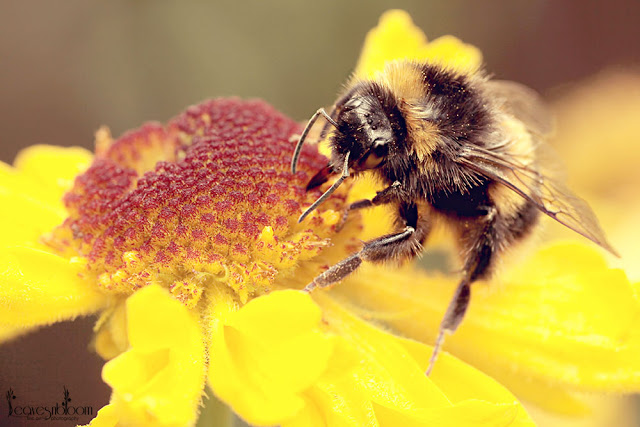 |
| A bumblebee on Helenium ‘Pipsqueak’ |
While the hoverflies don’t seem to mind which flowers they feed from and they are everywhere in the garden.
 |
| Hoverfly feeding on Helenium ‘Wyndley’ – rich nectar flowers |
Chives
 |
| Volucella pellucens drinking from Chive flowers – rich nectar flowers |
While on the odd occasion the largest of the UK hoverflies Volucella pellucens will even drop in for a drink.
The Nectar bar sure can be a busy place! Come back soon as I’ll be sharing more of the nectar rich plants that I have flowering at the moment in the garden.
What plants do the pollinators favour in your garden at the moment?
————————————————————————————————————
Footnotes
















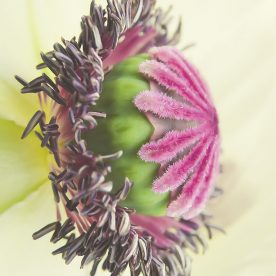
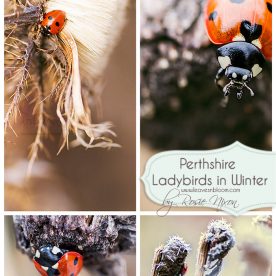
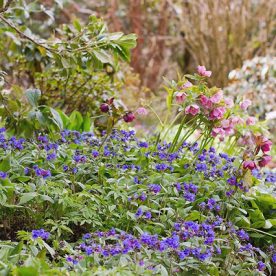
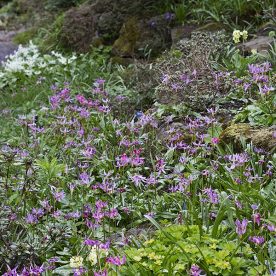
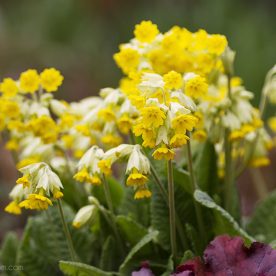
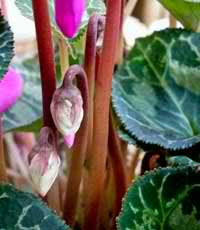
Mark and Gaz
Pollinators are always a welcome sight in the garden and brings some cheer as you watch them do their business 🙂
Anna
I enjoyed your post Rosie. Fascinating information about what the bee is saying via leg signals. I've noticed lots of bees attracted to astrantias this year but have not observed them on linarias. Mine have mainly gone over now but will have to observe next year. We had a brilliant speaker Maureen Little at our garden club recently who talked about gardening for bees. Her book 'The Bee Garden' is available on Kindle at at a bargain price at the moment.
Landscape Design By Lee
Great macros. I love how you captured the bees in motion!
rusty duck
The only thing I can add to your list is Veronica, mine is covered in just about anything that flies currently.
Fantastic photos, I love the one of the bee on the astrantia!
Lyn
Lovely to see those insects in so much detail. It's late winter here but the bees are busy already. In my garden, they are concentrating on the flowering quince, almond tree and Veronica umbrosa, as well as all the bulb flowers. I haven't seen any other pollinators yet – the bees always get to the nectar bar first!
Melanie J Watts
Interesting to read about bee behaviour Rosie. Lately bees and wasps in my garden are all stuck to the flower heads of sunflowers, like pieces of metal on a magnet.
Helena
Great photos of pollinators, lovely blog which I have just found! I'd welcome a post (unless you have already done one) on your favourite camera equipment, what lenses can you not live without?
Labli
Great macros. I love how you captured the bees in motion!
Rosie Nixon
Thanks Mark and Gaz the activity has been amazing this year.
Rosie Nixon
Thanks very much Landscape Design By Lee
Rosie Nixon
thanks rusty duck oh how I wish I could grow Veronica properly – it really struggles in my soil.
Rosie Nixon
Thanks Lyn You are so fortunate to have wildlife in the garden during that season. We don't have any pollinators flying about when it's so cold here in the winter.
Rosie Nixon
thanks Melanie J Watts magnets is the perfect description – just as well it's not those dreadful caterpillars you had earlier in the season.
Rosie Nixon
I'll try and do one sometime Helena I suppose I couldn't do without my Canon f1.4 50 mm lens as it's fast, great for low light conditions and creates beautiful bokeh.